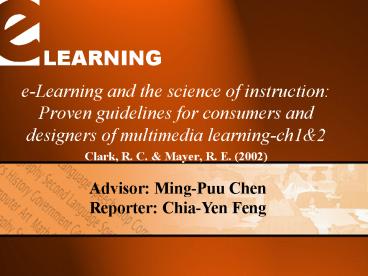LEARNING - PowerPoint PPT Presentation
1 / 23
Title:
LEARNING
Description:
LEARNING e-Learning and the science of instruction: Proven guidelines for consumers and designers of multimedia learning-ch1&2 Clark, R. C. & Mayer, R. E. (2002) – PowerPoint PPT presentation
Number of Views:224
Avg rating:3.0/5.0
Title: LEARNING
1
LEARNING
- e-Learning and the science of instruction Proven
guidelines for consumers and designers of
multimedia learning-ch12 - Clark, R. C. Mayer, R. E. (2002)
Advisor Ming-Puu Chen Reporter Chia-Yen Feng
2
Chapter 1e-Learning promise pitfalls
3
Outline
- Definition of e-Learning
- A description of different types of e-Learning
- Potential benefits and drawbacks to e-Learning
4
What is e-Learning?
- What
- Includes content (information)
- Uses instructional methods (techniques)
- How
- Uses media elements
- Why
- Builds new knowledge and skills
e - Learning
5
e-Learning development process
- Performance analysis
- Help meet important organizational goals by
filling a gap in knowledge and skills - e-learning is the best delivery solution
- Defining e-Learning content
- Job or content analysis
- Content types
- Fact, concept, process, procedures, principles
- Design
- Create a course blueprint
- Development
- Testing implementation
- Defining the instructional methods media
elements - How delivery platforms influence instructional
methods and media elements
6
Five types of content in e-Learning
- Fact
- Specific and unique data or instance
- Concept
- A category that includes multiple examples
- Process
- A flow of events or activities
- Procedure
- Take performed with step-by-step actions
- Principle
- Task perform by adopting guidelines
7
e-Learning goals
- Inform programs
- Build awareness or provides information
- Perform programs
- Build specific skills
- Two types
- Procedural (near transfer,?????)
- Principle-based (far transfer,?????)
8
Is e-Learning better? Media comparison research
- The hundreds of media comparison studies have
shown no difference in learning - All the media comparison research is that its
not the medium ? the instructional methods that
cause learning - Each medium offers unique opportunities to
deliver instructional method ? effectively
support human learning
9
What make e-Learning unique?
- Practice with feedback
- Responds with hints or feedback supporting
immediate correction or errors - Collaboration in self-study
- There is a growing research base on the benefits
of learning together versus solo - Use of simulation to accelerate expertise
10
e-Learning the pitfalls
- Failure to base e-Learning on job analysis
- Lessons do not build knowledge and skills that
transfer to the job - Failure to accommodate human learning processes(
human learning limits and strengths) - Lesson overload cognitive process and learning is
disrupted - E-learning dropout
- Learner do not complete their instruction
11
What is good e-Courseware
- Training goals
- Inform student, perform procedure, perform
principle - Learner difference (the prior knowledge)
- Instructional methods appropriate to the
learners characteristics( e.g learning styles,
prior knowledge) - Training environment
- Technical constraint
- Cultural factors
- Pragmatic constraint (e.g. budge, time,
management expectations)
12
Three types of e-Learning
- Receptive information acquisition
- Receptive instruction (show-and-tell)
- Include lots of information with limited practice
opportunities - Designed for inform goals
- Directive response strengthening
- Directive instruction (show-and -do)
- Require frequent responses from learners with
immediate feedback - Drill and practice
- Designed for perform-procedure goals
- Guided discovery knowledge construction
- Provide job-realistic problems and supporting
resources - Designed for perform-principle goals
13
Chapter2 how people learn from e-Course
14
Outline
- How do people learn
- How e-Lessons affect human learning
- What is good research
15
How do people learn?(1/3)
- Two channelsvisual auditory
- Limited capacity for processing information
- Learning occurs by active processing in memory
information - New knowledge and skills ? retrieved form LTM
- ?transfer to job
16
How do people learn?(2/3)
- The center of cognition since all active thinking
take places there - A limited of capacity memory
17
How do people learn?(3/3)
- Encoding
- Rehearsal
- retrieval
18
How e-lessons affect human learning (1/2)
- Selection of the importance information in the
lesson - Management of the limited capacity in working
memory to allow the rehearsal needed for learning - Coherence principle (ch7)
- Methods for integration
- Contiguity principle (ch4)
19
How e-lessons affect human learning (2/2)
- Methods for retrieval and transfer
- Methods for metacognitive monitoring
- Management of all of these process via
metacognitive skills - Self-check to asses oneself skill acquisition
20
Summary of learning processes
- Focus on key graphics and words in the lesson to
select what will be processed - Rehearse information in working memory to
organize and integrate it with existing knowledge
in LTM? apply cognitive load reduction tecniques - New knowledge stored in LTM must be retrieved
back on the job?transfer of learning - Metacognitive skills manage and adjust these
processes
21
What is good research?
- Informal studies (observational studies)
- Conclusion bases on feedback from and
observations of students - Controlled studies (experimental studies)
- Conclusion bases on outcome comparison of
randomly assigned participants to groups with
different treatments - Clinical trials (controlled field testing)
- Conclusion bases on outcome of lessons taken in
actual learning settings
22
How can you identify relevant research
- How similar are the learners in the research
study to your learner? - Are the conclusions based on an experimental
research design? - Are the experimental results replicated?
- Is learning measured by tests that measure
application? - Does the data analysis reflect statistical
significance as well as practical significance?
23
Interpretation of research statistics
- Means
- Standard deviation
- High averages and low SD
- Probability
- Effect size































